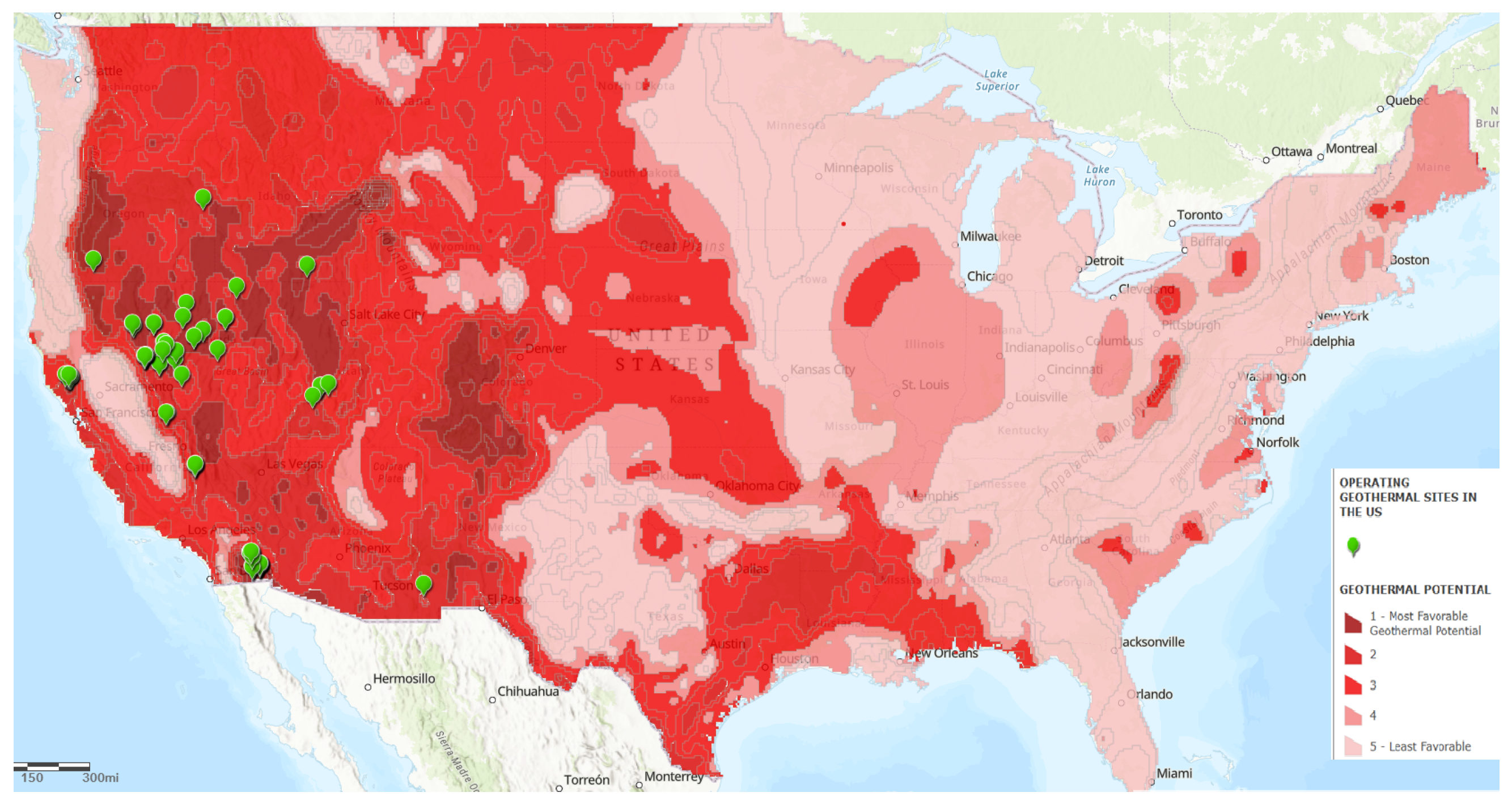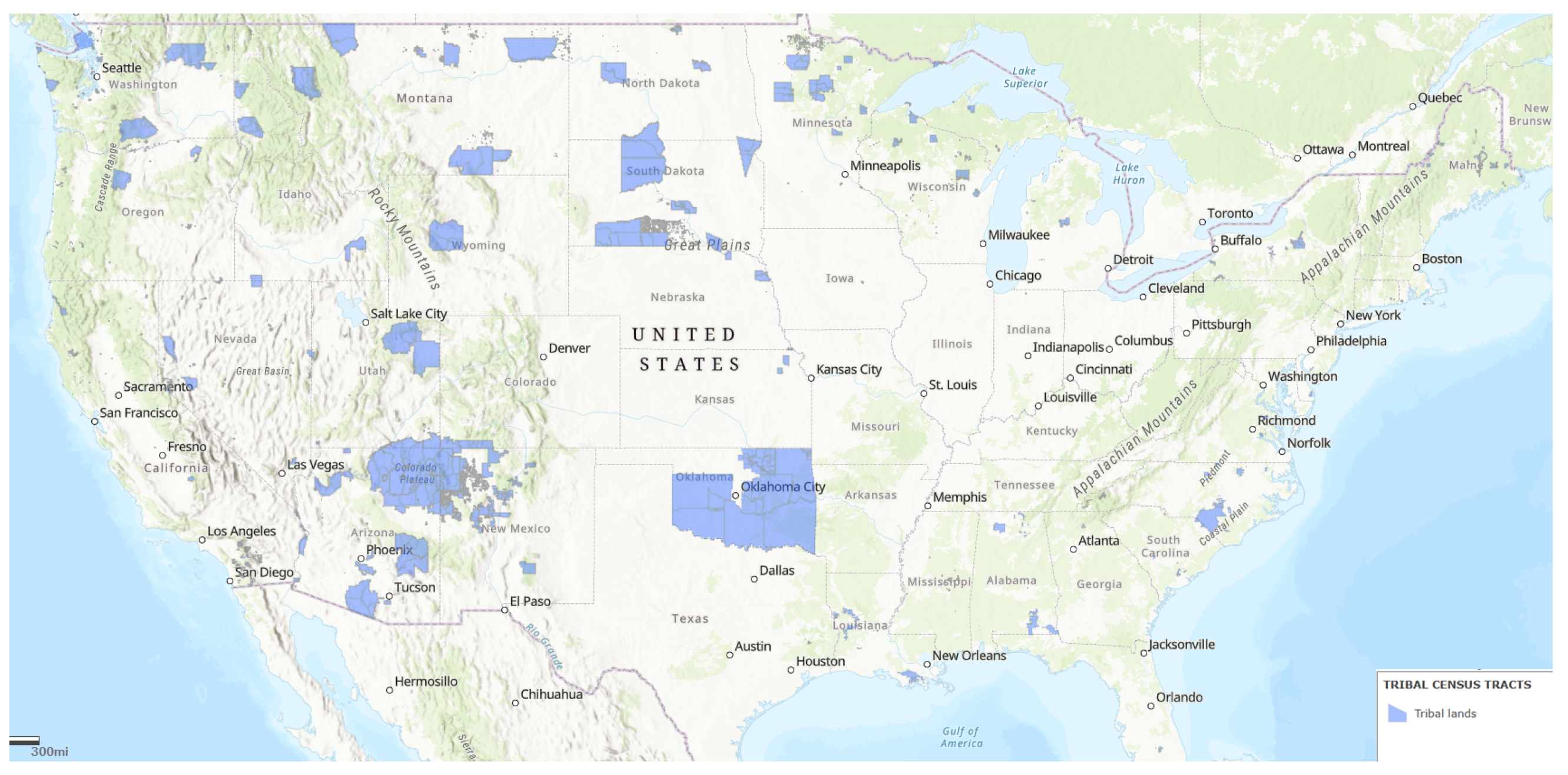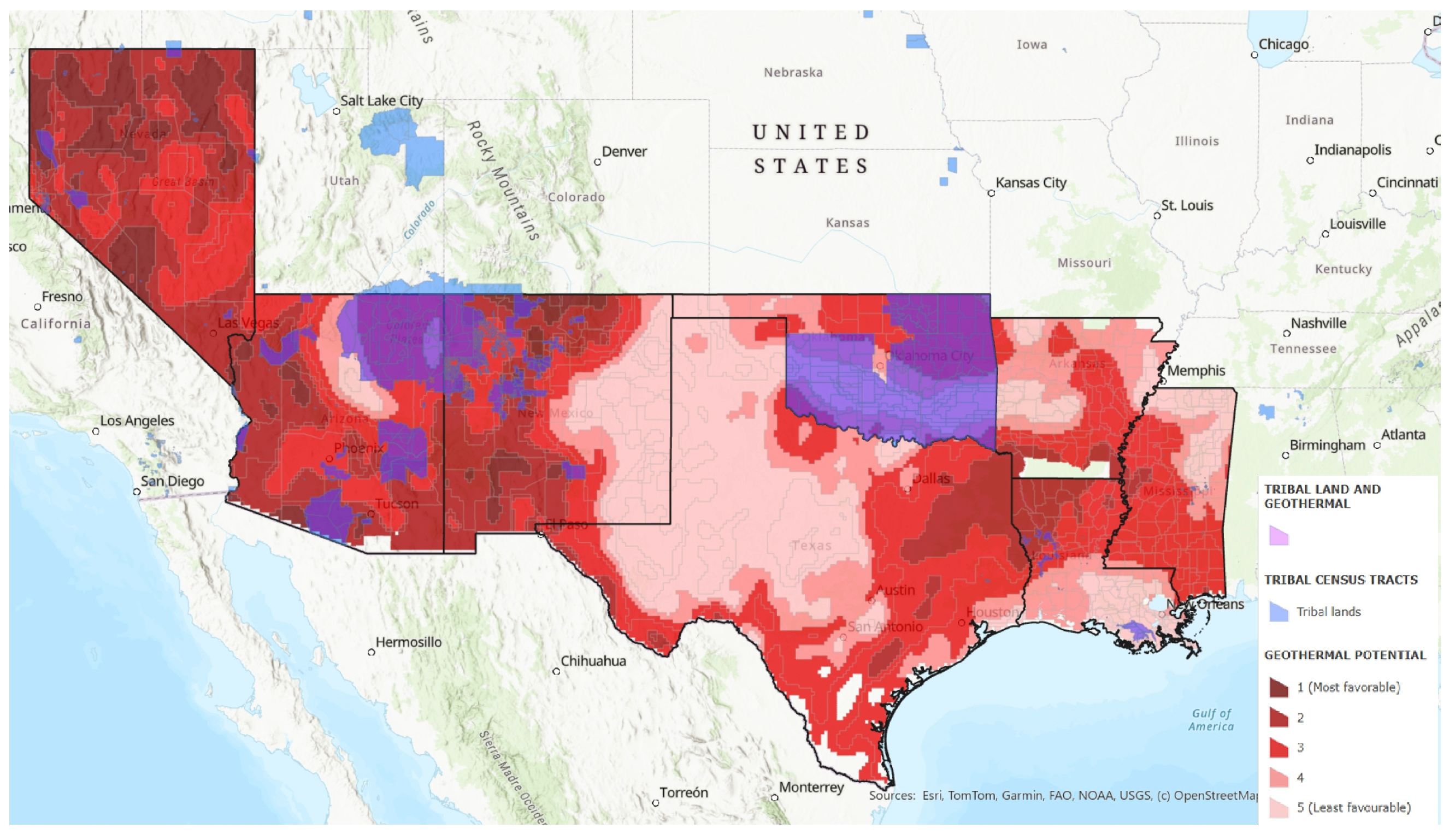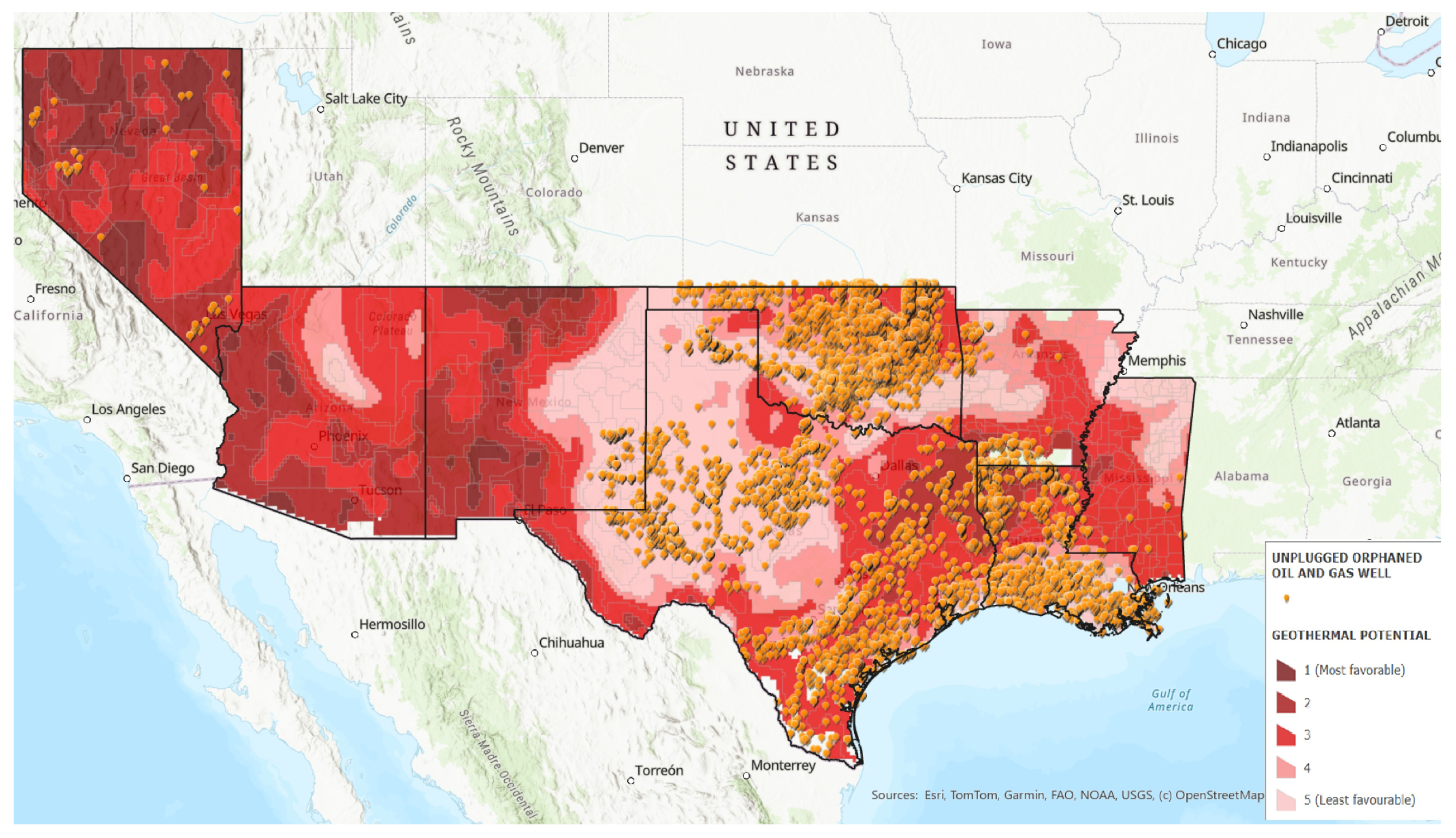Re-Energizing Legacy Fossil Infrastructure: Evaluating Geothermal Power in Tribal Lands and HUBZones
Abstract
1. Introduction
- Identify geographically where tribal lands, HUBZones, and areas with orphaned fossil fuel infrastructure are in the target area.
- Calculate how much geothermal energy can be produced from these lands using EGS technology.
- Discuss how these sites can leverage multiple policy tools to improve benefits for tribal and HUBZone communities.
2. Literature Review
2.1. Geothermal Energy
- Mitigating Pre-Existing Environmental Damage: Many abandoned oil and gas wells contribute to land subsidence, methane emissions, and groundwater contamination. Geothermal projects, when properly designed, can capture harmful emissions, stabilize subsiding land, and repurpose existing well bores, thereby acting as an environmental remediation strategy rather than an ecological disruptor [22].
- Optimized Water and Waste Management: Studies indicate that wastewater and solid waste contamination are significant concerns in geothermal projects [23,24,25]. However, injecting extracted geothermal fluids back into the reservoirs, a process already employed in enhanced geothermal systems, helps maintain reservoir pressure and reduce contamination risks [26,27].
- Infrastructure Utilization and Economic Continuity: Unlike other renewable energy sources that require extensive new infrastructure, geothermal energy can repurpose legacy oil and gas assets, including well bores and pipelines, reducing both cost and environmental footprint. This approach ensures continuity for skilled energy workers, many of whom can transition from fossil fuel jobs to geothermal operations without requiring significant retraining [28].
2.2. Site Selection for Energy Resources
2.3. GISs for Energy Resource Assessment
2.4. Tribal Lands, HUBZones, and Energy Development
2.5. Repurposing Abandonded Fossil Fuel Infrastructure
2.6. Geothermal Capacity Estimation
2.7. Literature Gap
3. Methodology
3.1. Overview
- Data Preprocessing—Cleaning and handling null values, removing redundant information, and extracting key variables from the shapefiles.
- Data Integration and Merging—Consolidating layers into a single dataset for a comprehensive analysis.
- Ranking and Suitability Assessment—Applying a scoring system based on geothermal potential and environmental considerations, such as the presence of tribal lands.
3.2. Data Collection and Preparation
- Historically Underutilized Business Zone (HUBZone): United States Small Business Adminsistration shapefiles were acquired from the Live Atlas tool in ArcGIS Online [55]. The HUBZone layers and the tribal lands were a subset of the Justice40 census tracts. The Justice40 census tracts included communities where more than 65 percent of households are at or below twice the federal poverty level and that also experienced at least one other environmental, economic, or health burden, covering 29% of the U.S. population [56,57]. Therefore, our study used Justice40 shapefiles, which fully incorprated all HUBZones and tribal lands, but also included a few other relevant communties.
3.3. Data Preprocessing and Analysis
- Data Extraction: Specific attributes and features of interest, such as geothermal potential class level and tribal land boundaries, were extracted from the larger datasets. Layers irrelevant to the scope of the study were excluded at this stage.
- Handling Null and Redundant Values: Missing values within the datasets, such as gaps, null values, or incomplete records, were addressed through interpolation techniques and the removal of records that did not meet the threshold for analysis. Redundant attributes from the merged shapefiles were removed to streamline the dataset.
- Data Quality Control: The dataset was reviewed for consistency and accuracy, ensuring that all spatial layers aligned correctly in the GIS environment. Any misalignment between layers was corrected.
- Data Integration and Merging: Using ArcGIS Pro’s data management tools, we merged the geothermal potential layers and segregated tribal land layers into a single layer.
3.4. Ranking and Suitability Analysis
- Geothermal Potential Classification: Sites were classified into five classes (Class 1 to Class 5) based on the Levelized Cost of Electricity (LCOE) associated with each location:
- –
- Class 1: Most favorable geothermal sites, offering the lowest LCOE. These areas were identified as the most favorable for geothermal development due to their low LCOE and proximity to high geothermal temperatures.
- –
- Class 2–4: The intermediate classes with low to moderate LCOE. These areas were progressively less favorable, either due to higher LCOE or lower geothermal temperatures.
- –
- Class 5: Least favorable geothermal sites, with higher LCOE. Class 5 regions, while still containing geothermal resources, may require advanced extraction technologies to be economically viable.
- –
- Class 999: Sites where temperatures at a 10 km depth were below 150 °C and thus were not considered suitable for deep geothermal energy extraction.
3.5. Geothermal Capacity Estimation
3.5.1. Capacity Estimation for Repurposed Oil/Gas Wells into Geothermal Plants
3.5.2. Capacity Estimation for Enhanced Geothermal Plants
3.5.3. Geothermal Capacity Estimation for Each Land Category
4. Results
4.1. Geothermal Potential
4.2. Calculated Geothermal Land Area
4.3. Tribal Lands and Geothermal Potential
- Arizona, New Mexico, and Oklahoma: These states feature a majority of tribal states with geothermal sites (Class 1, Class 2, and Class 3). These areas should be prioritized for further feasibility studies, with active collaboration with local indigenous communities.
- Arkansas, Texas, and Louisiana: These states have large amounts of high-potential geothermal sites. However, they have few or no tribal lands.
- Nevada: As a known geothermal hotspot, Nevada’s Class 1 areas provide significant potential for geothermal energy, but not on tribal lands.
4.4. HUBZones and Geothermal Potential
4.5. Orphaned Oil and Gas Wells
4.6. Tribal Lands, Orphaned Oil and Gas Wells, and Geothermal Potential
4.7. HUBZones, Tribal Lands, Orphaned Oil and Gas Wells, and Geothermal Potential
4.8. Potential Geothermal Capacity
5. Discussion
5.1. The Indian Energy Purchase Preference: A Long-Delayed Mechanism for Advancing Geothermal Development
5.2. Limitations of the Study
6. Conclusions
Future Work and Study Significance
Author Contributions
Funding
Data Availability Statement
Conflicts of Interest
References
- U.S. Department of Energy. Geothermal Basics. 2021. Available online: https://www.energy.gov/eere/geothermal/geothermal-basics (accessed on 24 January 2025).
- Horne, R.; Genter, A.; McClure, M.; Ellsworth, W.; Norbeck, J.; Schill, E. Enhanced geothermal systems for clean firm energy generation. Nat. Rev. Clean Technol. 2025, 1, 148–160. [Google Scholar] [CrossRef]
- Caulk, R.A.; Tomac, I. Reuse of abandoned oil and gas wells for geothermal energy production. Renew. Energy 2017, 112, 388–397. [Google Scholar] [CrossRef]
- The White House. Declaring a National Energy Emergency; The White House: Washington, DC, USA, 2025.
- U.S. Small Business Administration. HUBZone Program; U.S. Small Business Administration: Washington, DC, USA, 2025. Available online: https://www.sba.gov/federal-contracting/contracting-assistance-programs/hubzone-program (accessed on 24 January 2025).
- U.S. Department of the Interior. Orphaned Wells. 2025. Available online: https://www.doi.gov/orphanedwells (accessed on 24 January 2025).
- Jillian Neuberger, T.C.; Saha, D. How the US Can Address Legacy Fossil Fuel Sites for a Clean Energy Future. 2021. Available online: https://www.wri.org/insights/addressing-us-legacy-fossil-fuel-infrastructure (accessed on 24 January 2025).
- IRS. Clean Electricity Production Credit. 2025. Available online: https://www.irs.gov/credits-deductions/clean-electricity-production-credit (accessed on 24 January 2025).
- IRS. Clean Electricity Investment Credit. 2025. Available online: https://www.irs.gov/credits-deductions/clean-electricity-investment-credit (accessed on 24 January 2025).
- US Department of Energy. Indian Energy Purchase Preference—Background and Resources. 2025. Available online: https://www.energy.gov/indianenergy/indian-energy-purchase-preference-background-and-resources (accessed on 24 January 2025).
- Ricks, W.; Voller, K.; Galban, G.; Norbeck, J.H.; Jenkins, J.D. The role of flexible geothermal power in decarbonized electricity systems. Nat. Energy 2024, 10, 28–40. [Google Scholar] [CrossRef]
- Castelvecchi, D. Geothermal power is vying to be a major player in the world’s clean-energy future. Nat. Rev. Clean Technol. 2024, 635, 794–795. [Google Scholar] [CrossRef] [PubMed]
- Lazard. Lazard’s Levelized Cost of Energy Analysis; Version 17.0; With Support from Roland Berger; Lazard: Hamilton, Bermuda, 2024. [Google Scholar]
- Kwon, Y.S.; Li, Y.; Huang, B. Scalable, Low-Cost Fabrication of Selective Solar Absorber by Ultrasonic Spray Coating. ES Mater. Manuf. 2023, 20, 812. [Google Scholar] [CrossRef]
- Fauzi, F.N.; Puryantini, N.; Prabowo, A.R.; Adiputra, R.; Carvalho, H.; Danardono, D.; Tjahjana, D.P.; Firdaus, N.; Jurkovič, M. Implementation Assessment of the Offshore Wind Turbine (OWT) for Remote Regions’ Electrification in Indonesia Based on Geographical Potential and Economic Attractiveness. Eng. Sci. 2024, 32, 1295. [Google Scholar] [CrossRef]
- Massachusetts Institute of Technology. The Future of Geothermal Energy. 2006. Available online: https://energy.mit.edu/wp-content/uploads/2006/11/MITEI-The-Future-of-Geothermal-Energy.pdf (accessed on 24 January 2025).
- Sharmin, T.; Khan, N.R.; Akram, M.S.; Ehsan, M.M. A State-of-the-Art Review on Geothermal Energy Extraction, Utilization, and Improvement Strategies: Conventional, Hybridized, and Enhanced Geothermal Systems. Int. J. Thermofluids 2023, 18, 100323. [Google Scholar] [CrossRef]
- Liu, J.; Shao, C.; Yang, B.; Ngata, M.R.; Mwangomba, M.; Josephat, S.; Aminu, M.D. Advances in enhanced geothermal systems: Integrating laboratory, numerical and field insights. Appl. Therm. Eng. 2024, 249, 123350. [Google Scholar] [CrossRef]
- Augustine, C. Update to Enhanced Geothermal System Resource Potential Estimate; Technical Report NREL/CP-6A20-66428; National Renewable Energy Laboratory (NREL): Golden, CO, USA, 2016. [Google Scholar]
- Brookhart, T.; Batts, D.; Peterson, J. Geothermal Energy Resources and Policiesof the Western States; U.S. Bureau of Land Management: Washington, DC, USA, 2009. Available online: https://www.idahogeology.org/pub/Geothermal/References/Miscellaneous/Brookhart.etal-US.2009-GeothermalResourcesPoliciesWesternUS.pdf (accessed on 24 January 2025).
- Lynn Scarlett. Geothermal Energy. 2006. Available online: https://doi.gov/ocl/geothermal-energy (accessed on 24 January 2025).
- Haninger, K.; Ma, L.; Timmins, C. The Value of Brownfield Remediation. J. Assoc. Environ. Resour. Econ. 2017, 4, 197–241. [Google Scholar] [CrossRef]
- Bayer, P.; Rybach, L.; Blum, P.; Brauchler, R. Review on life cycle environmental effects of geothermal power generation. Renew. Sustain. Energy Rev. 2013, 26, 446–463. [Google Scholar] [CrossRef]
- Shortall, R.; Davidsdottir, B.; Axelsson, G. Development of a sustainability assessment framework for geothermal energy projects. Energy Sustain. Dev. 2015, 27, 28–45. [Google Scholar] [CrossRef]
- Bošnjaković, M.; Stojkov, M.; Jurjević, M. Environmental Impact of Geothermal Power Plants. Teh. Vjesn. 2019, 26, 1515–1522. [Google Scholar] [CrossRef]
- Kagel, A.; Gawell, K. Promoting Geothermal Energy: Air Emissions Comparison and Externality Analysis. Electr. J. 2005, 18, 90–99. [Google Scholar] [CrossRef]
- Speight, D.J. Geothermal Energy: Renewable Energy and the Environment, Second Edition, by William E. Glassley. Energy Sources Part A Recover. Util. Environ. Eff. 2015, 37, 2039. [Google Scholar] [CrossRef]
- U.S. Department of Energy. Apprentices Earn While They Learn to Build the Clean Energy Future; U.S. Department of Energy: Washington, DC, USA, 2022.
- Derse, O.; Yilmaz, E. Site selection optimization for 100% renewable energy sources. Environ. Sci. Pollut. Res. 2024, 31, 26790–26805. [Google Scholar] [CrossRef] [PubMed]
- Shao, M.; Han, Z.; Sun, J.; Xiao, C.; Zhang, S.; Zhao, Y. A review of multi-criteria decision making applications for renewable energy site selection. Renew. Energy 2020, 157, 377–403. [Google Scholar] [CrossRef]
- Jones, E.C.; Yaw, S.; Bennett, J.A.; Ogland-Hand, J.D.; Strahan, C.; Middleton, R.S. Designing multi-phased CO2 capture and storage infrastructure deployments. Renew. Sustain. Energy Transit. 2022, 2, 100023. [Google Scholar] [CrossRef]
- Jones, E.C. Lithium Supply Chain Optimization: A Global Analysis of Critical Minerals for Batteries. Energies 2024, 17, 2685. [Google Scholar] [CrossRef]
- Avtar, R.; Sahu, N.; Aggarwal, A.K.; Chakraborty, S.; Kharrazi, A.; Yunus, A.P.; Dou, J.; Kurniawan, T.A. Exploring Renewable Energy Resources Using Remote Sensing and GIS—A Review. Resources 2019, 8, 149. [Google Scholar] [CrossRef]
- Zinovieva, I.S.; Iatsyshyn, A.V.; Artemchuk, V.O.; Stanytsina, V.V.; Sheludchenko, L.S.; Popov, O.O.; Kovach, V.O.; Iatsyshyn, A.V. The use of GIS in renewable energy specialist’s learning. J. Phys. Conf. Ser. 2023, 2611, 012016. [Google Scholar] [CrossRef]
- Varekar, S.; Srinivasan, S.; Shah, N.; Gopalakrishnan, N.E., Jr. Analyzing the Connectivity of Combined Statistical Areas in Different Census Regions Using ArcGIS. Int. Supply Chain Technol. J. 2023, 9. [Google Scholar] [CrossRef]
- US Department of Energy. Tribal Electricity Access Reliability Report to Congress. 2024. Available online: https://www.energy.gov/sites/default/files/2024-01/EXEC-2023-000952%20-%20Tribal%20Electricity%20Access%20Reliability%20Report%20to%20Congress%20%28Final%20Draft%20-%20Clean%29-signed%20by%20S1.pdf (accessed on 24 January 2025).
- Bureau of Indian Affairs. Renewable Energy Development Program. 2024. Available online: https://www.bia.gov/bia/ots/demd/renewable-energy (accessed on 24 January 2025).
- Mara, K.; Zhang, N.; He, M. Tribal Financial Access to Renewable Energy: Full Report. 2024. Available online: https://foster.uw.edu/wp-content/uploads/2024/06/Tribal-Financial-Access-to-Renewable-Energy-Full-Report.pdf (accessed on 24 January 2025).
- Grosse, C.; Mark, B. Does renewable electricity promote Indigenous sovereignty? Reviewing support, barriers, and recommendations for solar and wind energy development on Native lands in the United States. Energy Res. Soc. Sci. 2023, 104, 103243. [Google Scholar] [CrossRef]
- Farhar, B.C. Geothermal Access to Federal and Tribal Lands: A Progress Report. 2002. Available online: https://www.osti.gov/servlets/purl/1216040 (accessed on 24 January 2025).
- Peter Meisen, T.E. Renewable Energy on Tribal Lands. Available online: https://www.geni.org/globalenergy/research/renewable-energy-on-tribal-lands/Renewable-Energy-on-Tribal-Lands.pdf (accessed on 24 January 2025).
- Farhar, B.C.; Dunlevy, P. Native American Issues in Geothermal Energy; U.S. Bureau of Land Management: Washington, DC, USA, 2009. Available online: https://www1.eere.energy.gov/tribalenergy/guide/pdfs/grc030707.pdf (accessed on 24 January 2025).
- Jones, E.C.; Reyes, A. Identifying Themes in Energy Poverty Research: Energy Justice Implications for Policy, Programs, and the Clean Energy Transition. Energies 2023, 16, 6698. [Google Scholar] [CrossRef]
- Pena Cabra, I.; Izar-Tenorio, J.; Sharma, S.; Clahane, L.; Iyengar, A.K. With uncertainty comes opportunity: Repurposing coal assets to create new beginnings in the U.S. Electr. J. 2024, 37, 107431. [Google Scholar] [CrossRef]
- Meenakshisundaram, A.; Tomomewo, O.S.; Aimen, L.; Bade, S.O. A comprehensive analysis of repurposing abandoned oil wells for different energy uses: Exploration, applications, and repurposing challenges. Clean. Eng. Technol. 2024, 22, 100797. [Google Scholar] [CrossRef]
- Blackwell, D.D.; Negraru, P.T.; Richards, M.C. Assessment of the Enhanced Geothermal System Resource Base of the United States. Nat. Resour. Res. 2007, 15, 283–308. [Google Scholar] [CrossRef]
- Mullane, M.; Gleason, M.; McCabe, K.; Mooney, M.; Reber, T.; Young, K.R. An Estimate of Shallow, Low-Temperature Geothermal Resources of the United States; Technical Report NREL/CP-6A20-66461; National Renewable Energy Laboratory (NREL): Golden, CO, USA, 2016.
- Augustine, C.; Fisher, S.; Ho, J.; Warren, I.; Witter, E. Enhanced Geothermal Shot Analysis for the Geothermal Technologies Office; Technical Report NREL/TP-5700-84822; National Renewable Energy Laboratory (NREL): Golden, CO, USA, 2023.
- Pinchuk, P.; Thomson, S.M.; Trainor-Guitton, W.; Buster, G.; Maclaurin, G. Development of a Geothermal Module in reV: Quantifying the Geothermal Potential While Accounting for the Geospatial Intersection of the Grid Infrastructure and Land Use Characteristics; National Renewable Energy Laboratory (NREL): Golden, CO, USA, 2021.
- Aljubran, M.J.; Horne, R.N. Power Supply Characterization of Baseload and Flexible Enhanced Geothermal Systems. Sci. Rep. 2024, 14, 17619. [Google Scholar] [CrossRef]
- USGS. U.S. Geothermal Systems Map. 2024. Available online: https://www.usgs.gov/media/images/us-geothermal-systems-map (accessed on 24 January 2025).
- Texas Department of Transportation. Texas County Boundaries. 2024. Available online: https://uta-arcgis.maps.arcgis.com/home/item.html?id=9b2eb7d232584572ad53bad41c76b04d (accessed on 24 January 2025).
- Nevada Legislative Counsel Bureau. Nevada Counties (Polygon). 2024. Available online: https://uta-arcgis.maps.arcgis.com/home/item.html?id=63ddb5c81799450fabd13439a81f0562 (accessed on 24 January 2025).
- U.S. Energy Information Administration. Renewable Energy Map Resource. 2024. Available online: https://uta-arcgis.maps.arcgis.com/home/item.html?id=6515281935cc4cc1afdd585358d0aee3 (accessed on 24 January 2025).
- U.S. Small Business Administration. HUBZone Map. 2025. Available online: https://maps.certify.sba.gov/hubzone/map# (accessed on 24 January 2025).
- Courtney Lindwall. What Is the Justice40 Initiative? 2023. Available online: https://www.nrdc.org/stories/what-justice40-initiative (accessed on 24 January 2025).
- The White House gov. Justice40 A Whole-of-Government Initiative. 2022. Available online: https://bidenwhitehouse.archives.gov/environmentaljustice/justice40/ (accessed on 24 January 2025).
- Esri US Federal Data. Tribal Census Tracts. 2024. Available online: https://uta-arcgis.maps.arcgis.com/home/item.html?id=fb1b067232314b719ae74fb5c4b94199 (accessed on 24 January 2025).
- USA 2020 Census Race and Ethnicity Characteristics—Tribal Geographies. U.S. Census Bureau’s Data. 2023. Available online: https://uta-arcgis.maps.arcgis.com/home/item.html?id=1f3ceb7f96464b329d1a8a64c787cd0c (accessed on 24 January 2025).
- Wilmarth, M.; Stimac, J. Power density in geothermal fields. Power 2015, 19, 25. [Google Scholar]
- Colin, F.; Williams, M.J.R.; Anderson, A.F. Updating the Classification of Geothermal Resources. 2011. Available online: https://www.energy.gov/eere/geothermal/articles/updating-classification-geothermal-resources (accessed on 24 January 2025).
- Wight, N.; Bennett, N. Geothermal energy from abandoned oil and gas wells using water in combination with a closed wellbore. Appl. Therm. Eng. 2015, 89, 908–915. [Google Scholar] [CrossRef]
- Santos, L.; Taleghani, A.D.; Elsworth, D. Repurposing abandoned wells for geothermal energy: Current status and future prospects. Renew. Energy 2022, 194, 1288–1302. [Google Scholar] [CrossRef]
- Zinsalo, J.M.; Lamarche, L.; Raymond, J. Performance analysis and working fluid selection of an Organic Rankine Cycle Power Plant coupled to an Enhanced Geothermal System. Energy 2022, 245, 123259. [Google Scholar] [CrossRef]
- Aydin, H.; Yüksel, S.; Topuz, C. Utilization of Oil and Gas Wells for Geothermal Applications. In Proceedings of the 49th Workshop on Geothermal Reservoir Engineering, Stanford University, Stanford, CA, USA, 12–14 February 2024. [Google Scholar]
- Al-Weshahi, M.A.; Latrash, F.; Anderson, A.; Agnew, B. Working fluid selection of low grade heat geothermal Organic Rankine Cycle (ORC). Int. J. Therm. Technol. 2014, 4, 6–14. [Google Scholar]
- Akhmadullin, I. Utilization of Co-Produced Water from Oil Production: Energy Generation Case. In Proceedings of the SPE Health Safety, Security, Environment, & Social Responsibility Conference-North America, New Orleans, LA, USA, 18–20 April 2017; p. D031S017R003. [Google Scholar]
- Geothermal|Electricity|2024|ATB|NREL. Available online: https://atb.nrel.gov/electricity/2024/geothermal (accessed on 24 January 2025).
- Lopez, A.; Zuckerman, G.R.; Pinchuk, P.; Gleason, M.; Rivers, M.; Roberts, O.; Williams, T.; Heimiller, D.; Thomson, S.M.; Mai, T.; et al. Renewable Energy Technical Potential and Supply Curves for the Contiguous United States, 2024th ed.; National Renewable Energy Laboratory (NREL): Golden, CO, USA, 2025.
- DiGangi, D. Interior Approves 2-GW Fervo Energy Geothermal Project in Utah. 2024. Available online: https://www.utilitydive.com/news/interior-geothermal-fervo-energy-categorical-exclusion-nepa/730413/ (accessed on 24 January 2025).
- Ritzinger, B.; Glen, J.; Peacock, J.; Blakely, R.; Mills, P.; Staisch, L.; Bennett, S.; Sherrod, B. Geothermal Potential of the Umatilla Indian Reservation, Oregon: Evidence from Detailed Geophysical Investigations. 2018. Available online: https://pubs.usgs.gov/publication/70259533 (accessed on 24 January 2025).
- NREL. Developing Clean Energy Projects on Tribal Lands. 2013. Available online: https://www.nrel.gov/docs/fy13osti/57748.pdf (accessed on 24 January 2025).







| Class | Temperature Range (°C) |
|---|---|
| Class 1 | >150 °C |
| Class 2 | 130–150 °C |
| Class 3 | 110–130 °C |
| Class 4 | 90–110 °C |
| Class 5 | <90 °C |
| Class 999 | No temperature data |
| Parameter (Unit) | Chena Alaska ORC Unit [66] | Simulation Analysis [67] | This Study |
|---|---|---|---|
| Refrigerant | R134a | R134a | R134a |
| Heat source temperature inlet (°F) | 164 | 164 | 164 |
| Turbine inlet pressure (bar) | 16 | 16 | 16 |
| Turbine outlet pressure (bar) | 4.39 | 4.39 | 4.39 |
| Refrigerant flow rate (kg/s) | 12.2 | 11.65 | 12 |
| Gross power production (kW) | 250 | 263.85 | 249 |
| Cycle efficiency (%) | 8.2 | 8.51 | 9 |
| Class | Total Land Area (Sq. Mi.) | HUBZones Land Area (Sq. Mi.) | Tribal Lands (Sq. Mi.) | Oil Wells (#) | # of Oil Wells in HUBZones (#) | # of Oil Wells in Tribal Communities |
|---|---|---|---|---|---|---|
| 1 | 32,050 | 10,090 | 1838 | 20 | 1 | 0 |
| 2 | 144,141 | 38,776 | 10,832 | 2200 | 201 | 22 |
| 3 | 196,118 | 74,051 | 48,026 | 12,000 | 5964 | 5752 |
| 4 | 221,513 | 22,641 | 18,729 | 2000 | 334 | 290 |
| 5 | 236,160 | 31,320 | 18,845 | 2300 | 663 | 370 |
| Total | 829,982 | 176,878 | 98,270 | 18,520 | 7163 | 6434 |
| Class | Total Potential (GW) | HUBZones (GW) | Tribal Lands (GW) | Oil Wells (GW) | Oil Wells (GW) in HUBZones | Oil Wells (GW) on Tribal Lands |
|---|---|---|---|---|---|---|
| Class 1 | 339.3 | 106.8 | 19.4 | 0.0 | 0.0 | 0.0 |
| Class 2 | 1002.6 | 269.7 | 75.3 | 0.7 | 0.1 | 0.0 |
| Class 3 | 1031.0 | 389.3 | 252.5 | 3.5 | 1.8 | 1.7 |
| Total | 2372.8 | 765.8 | 347.2 | 4.3 | 1.8 | 1.7 |
| Class | Max Potential Facilities | Hub Zones Max Facilities | Tribal Lands Max Facilities | Average Plant Capacity (MW) |
|---|---|---|---|---|
| Class 1 | 7696 | 2423 | 441 | 44.08 |
| Class 2 | 34,613 | 9311 | 2601 | 28.97 |
| Class 3 | 47,095 | 17,782 | 11,532 | 21.89 |
| Total | 89,404 | 29,516 | 14,574 | 94.94 |
Disclaimer/Publisher’s Note: The statements, opinions and data contained in all publications are solely those of the individual author(s) and contributor(s) and not of MDPI and/or the editor(s). MDPI and/or the editor(s) disclaim responsibility for any injury to people or property resulting from any ideas, methods, instructions or products referred to in the content. |
© 2025 by the authors. Licensee MDPI, Basel, Switzerland. This article is an open access article distributed under the terms and conditions of the Creative Commons Attribution (CC BY) license (https://creativecommons.org/licenses/by/4.0/).
Share and Cite
Jones, E.C., Jr.; Munjurpet Sridharan, C.; Aghapour, R.; Rodriguez, A. Re-Energizing Legacy Fossil Infrastructure: Evaluating Geothermal Power in Tribal Lands and HUBZones. Sustainability 2025, 17, 2558. https://doi.org/10.3390/su17062558
Jones EC Jr., Munjurpet Sridharan C, Aghapour R, Rodriguez A. Re-Energizing Legacy Fossil Infrastructure: Evaluating Geothermal Power in Tribal Lands and HUBZones. Sustainability. 2025; 17(6):2558. https://doi.org/10.3390/su17062558
Chicago/Turabian StyleJones, Erick C., Jr., Chandramouli Munjurpet Sridharan, Raziye Aghapour, and Angel Rodriguez. 2025. "Re-Energizing Legacy Fossil Infrastructure: Evaluating Geothermal Power in Tribal Lands and HUBZones" Sustainability 17, no. 6: 2558. https://doi.org/10.3390/su17062558
APA StyleJones, E. C., Jr., Munjurpet Sridharan, C., Aghapour, R., & Rodriguez, A. (2025). Re-Energizing Legacy Fossil Infrastructure: Evaluating Geothermal Power in Tribal Lands and HUBZones. Sustainability, 17(6), 2558. https://doi.org/10.3390/su17062558







